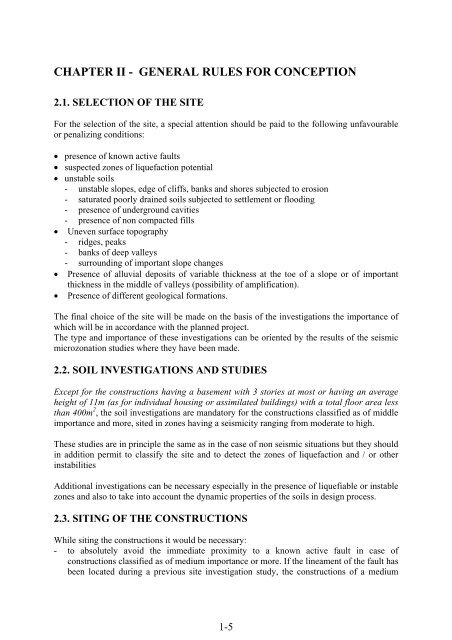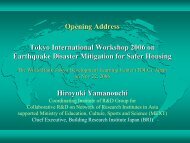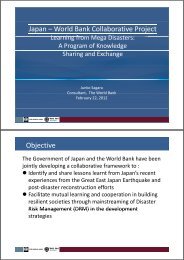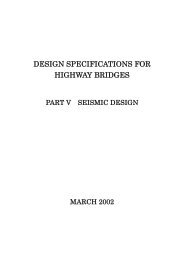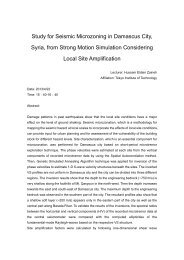algerian earthquake resistant regulations « rpa 99 - IISEE
algerian earthquake resistant regulations « rpa 99 - IISEE
algerian earthquake resistant regulations « rpa 99 - IISEE
You also want an ePaper? Increase the reach of your titles
YUMPU automatically turns print PDFs into web optimized ePapers that Google loves.
CHAPTER II - GENERAL RULES FOR CONCEPTION<br />
2.1. SELECTION OF THE SITE<br />
For the selection of the site, a special attention should be paid to the following unfavourable<br />
or penalizing conditions:<br />
• presence of known active faults<br />
• suspected zones of liquefaction potential<br />
• unstable soils<br />
- unstable slopes, edge of cliffs, banks and shores subjected to erosion<br />
- saturated poorly drained soils subjected to settlement or flooding<br />
- presence of underground cavities<br />
- presence of non compacted fills<br />
• Uneven surface topography<br />
- ridges, peaks<br />
- banks of deep valleys<br />
- surrounding of important slope changes<br />
• Presence of alluvial deposits of variable thickness at the toe of a slope or of important<br />
thickness in the middle of valleys (possibility of amplification).<br />
• Presence of different geological formations.<br />
The final choice of the site will be made on the basis of the investigations the importance of<br />
which will be in accordance with the planned project.<br />
The type and importance of these investigations can be oriented by the results of the seismic<br />
microzonation studies where they have been made.<br />
2.2. SOIL INVESTIGATIONS AND STUDIES<br />
Except for the constructions having a basement with 3 stories at most or having an average<br />
height of 11m (as for individual housing or assimilated buildings) with a total floor area less<br />
than 400m 2 , the soil investigations are mandatory for the constructions classified as of middle<br />
importance and more, sited in zones having a seismicity ranging from moderate to high.<br />
These studies are in principle the same as in the case of non seismic situations but they should<br />
in addition permit to classify the site and to detect the zones of liquefaction and / or other<br />
instabilities<br />
Additional investigations can be necessary especially in the presence of liquefiable or instable<br />
zones and also to take into account the dynamic properties of the soils in design process.<br />
2.3. SITING OF THE CONSTRUCTIONS<br />
While siting the constructions it would be necessary:<br />
- to absolutely avoid the immediate proximity to a known active fault in case of<br />
constructions classified as of medium importance or more. If the lineament of the fault has<br />
been located during a previous site investigation study, the constructions of a medium<br />
1-5


